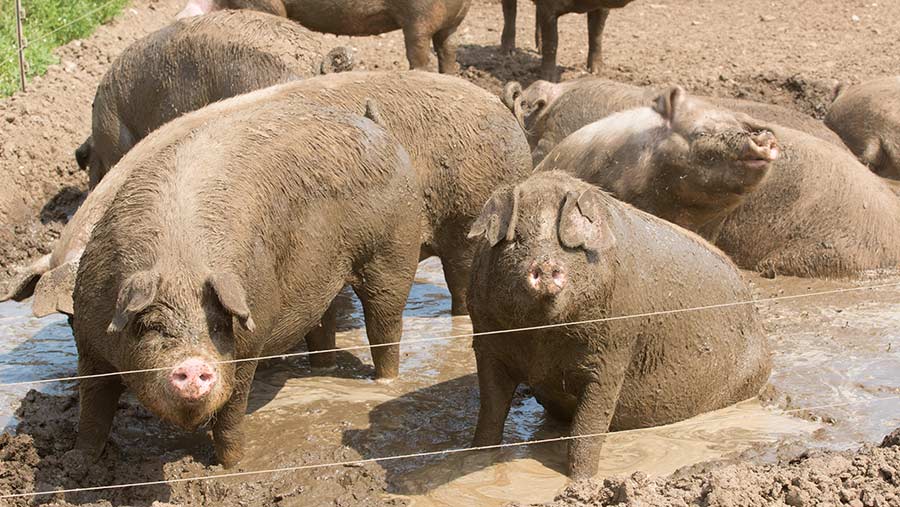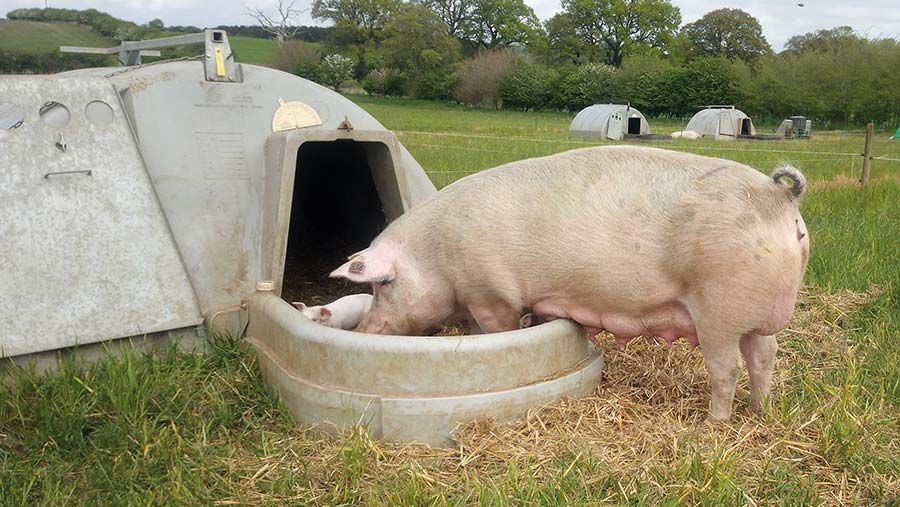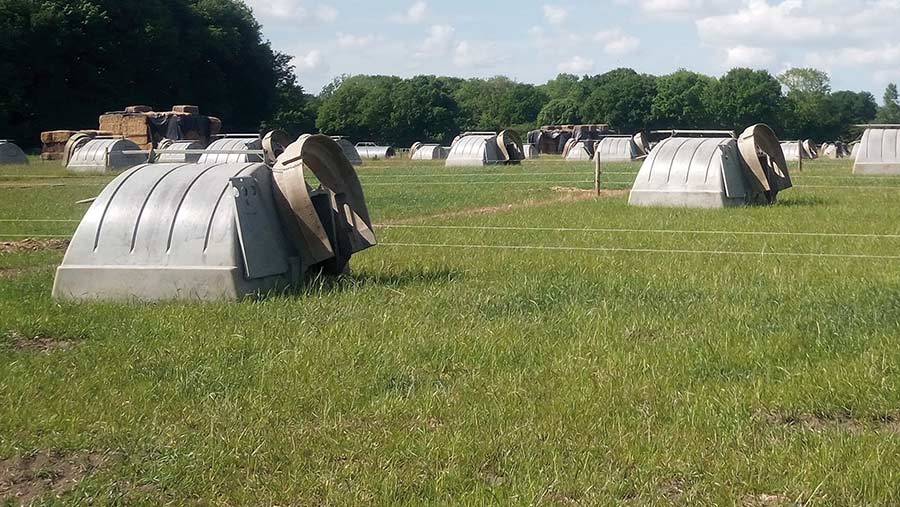7 ways to minimise heat stress in outdoor pigs
 © Tim Scrivener
© Tim Scrivener Keeping sows in smaller groups, using double-skinned dry sow huts and optimising stock management are among the strategies helping Rob McGregor keep heat stress to a minimum at his 1,550-head outdoor unit in Fakenham, Norfolk.
Stress caused by excess heat can have severe effects on pigs, leading to compromised performance and reduced fertility, and in the worst cases can be fatal.
Without mechanical cooling and ventilation systems, outdoor pigs are particularly vulnerable to the effects of heat, and so taking practical steps to reduce the risk is vital.
See also: Farmer Focus: Grass limits heat stress in pig herd
With extreme temperature fluctuations occurring more frequently in the UK, Mr McGregor – who rears pigs for LSB – has altered his approach to better manage heat stress.
“High temperatures seem to have got even higher over recent years, and the most dramatic thing is how quickly they can switch. We seem to have rapid peaks and then temperatures revert to normal. I think sows find this harder to cope with than a gradual increase in temperature.”
As such, he has made a number of changes.
1. Distinguishing between drinking and wallowing water
“We recently invested in a clean water tank to make a clear distinction between wallowing water and drinking water. For a long time, this came from just one source, which was not ideal for either purpose,” says Mr McGregor.
When water quality is poor, pigs will drink only the absolute minimum they need to for survival. But by giving them a separate source from a clean water tank – which is comparable with tap water quality – he has found they drink far more.
“Not only is this good from a hydration and heat stress perspective, but it also improves performance.”
2. Using insulated farrowing arks
Mr McGregor uses well-insulated farrowing arks, as in hot weather uninsulated ones can be hotter than the outside temperature. Opening up the back to get a breeze through also helps to provide a cooler area for sows and piglets.

© Rob McGregor
3. Double-skinned dry sow huts
Most dry sow huts are made from single-skin steel, but Mr McGregor has now started using huts with a double layer of steel. The cavity between the two layers creates a buffer against temperature changes.
4. Keeping sows in smaller groups
Maintaining smaller groups minimises the risk of heat stress caused by overstocking issues. It also means there are fewer pigs to each wallow, which maximises each animal’s opportunity to keep cool. “We have moved from groups of 20 to 12-15 and are seeing good results,” he says.

© Rob McGregor
5. Using grass cover crops
Mr McGregor has been trialling the use of grass leys for a range of reasons. He has noticed there is a definite reduction in heat stress where pigs are on grass, largely because this is cooler than lying on bare dirt.
“We have also found that grass reduces heat stress at the point of farrowing. Getting grass through the gut eliminates constipation, which is one of the key factors that can prolong farrowing. The quicker she farrows, the less chance of overheating.”
6. Replacing older, heavier boars
Heat can have a particularly detrimental effect on boars – especially the older and heavier ones, says Mr McGregor. “To avoid this, we now try to have a bit of a cull, starting at Christmas time, to replace the big boars with smaller ones. Boars are only used for cover duty, for catching returns, so keeping bigger ones which are likely to have a reduced performance as a result of the heat is unnecessary.”
7. Planning stock task timings
Keeping an eye on the weather forecast can be a helpful starting point for planning stock task timings. “For example, if we are moving stock, then it is best to do this early in the morning when the temperature is likely to be at it its lowest, or even the next day if possible.
“It is all about planning ahead to mitigate the risk.”
A pig vet’s top tips for reducing heat stress
Veterinarian Alex Thomsett, director at the George Veterinary Group, says that to reduce the risk of heat stress, it is important to understand how pigs lose heat. This happens in four main ways: convection, conduction, evaporation and radiation.
To maximise the pig’s ability to lose heat:
- Ensure you have made provisions for wallows and shaded areas. Pigs cannot sweat, so access to a wallow is important to enable heat loss
- Routinely check water points to make sure a clean, plentiful supply is always available
- Adapt stock management and consider feeding early and/or later in the day when it is likely to be cooler and pigs are more likely to want to eat. This will help to minimise intake fluctuations
- Consider painting dry sow and farrowing arcs white to reflect heat. Heat loss can only occur if there is a significant temperature difference between a pig’s body and its environment. Making provision for this by painting surfaces white can help to widen this temperature difference to allow heat loss through radiation
- Review semen handling in the field so semen is never heat shocked, which could lead to impaired sow fertility.
